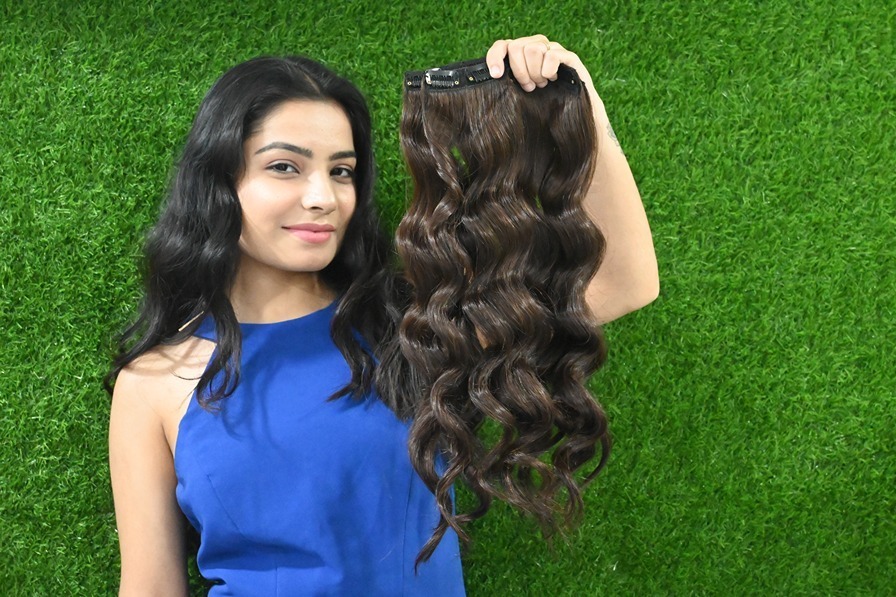Hair extensions are a fantastic way to add length, volume, and versatility to your hairstyle. Whether you’re aiming for waist-length waves, a voluminous ponytail, or just a touch of extra fullness, extensions open up a world of styling possibilities. However, a common question many users ask is: Can you color or heat-style hair extensions without damaging them? The answer is yes, but with several important caveats.
In this comprehensive guide, we’ll dive deep into everything you need to know about coloring and heat-styling hair extensions, from the types of extensions that can be styled to the best practices that keep them looking salon-fresh.
Understanding the Types of Hair Extensions
Before you pick up your flat iron or hair dye, it’s essential to know the type of extensions you’re working with. Hair extensions come in two main categories:
1. Human Hair Extensions
These are made from 100% real human hair and can usually be treated like your natural hair. They offer the highest quality and can be colored, curled, straightened, and blow-dried. However, how they’re processed before reaching you matters greatly in determining how well they’ll respond to heat or color.
2. Synthetic Hair Extensions
Made from man-made fibers such as acrylic or nylon, synthetic extensions are pre-styled and are not designed to handle high temperatures or chemical processing. Most synthetic hair will melt or become severely damaged under heat and cannot be colored with regular dyes.
Pro Tip: Always check the label or consult the manufacturer before applying heat or color to any type of extension.
Can You Color Hair Extensions?
Human Hair Extensions: Yes, But Be Cautious
If you have high-quality human hair extensions, you can color them, but there are some key guidelines to follow.
- Stick to darkening, not lightening: Human hair extensions have already been processed and chemically treated. Bleaching or lifting the color can weaken the hair structure, leading to dryness and breakage. If you must change the shade, it’s safer to go darker.
- Use professional-grade hair dye: Drugstore box dyes are often too harsh. Opt for semi-permanent or professional salon-quality color products that are less damaging.
- Do a strand test first: Always test the dye on a small, hidden section before applying it to the entire set to make sure the results are as expected.
- Condition thoroughly after coloring: Coloring can dry out the hair, so use a deep conditioner or mask immediately after and maintain weekly hydration treatments.
Synthetic Hair Extensions: No
Synthetic extensions cannot be colored with regular hair dye. The synthetic fibers simply don’t absorb pigment the way real hair does. Some people attempt to use fabric dye or alcohol-based markers to tint synthetic hair, but this is inconsistent and often leads to uneven or messy results.
Can You Heat-Style Hair Extensions?
Human Hair Extensions: Yes, With the Right Tools and Temperature
One of the main advantages of human hair extensions is their ability to be styled with heat tools such as flat irons, curling wands, and blow dryers. However, it’s important to approach heat styling with care to avoid damaging your extensions prematurely.
- Use a heat protectant spray: This is non-negotiable. Always apply a heat protectant before using any hot tools to help seal the hair cuticle and prevent moisture loss.
- Set your tools to low or medium heat: Unlike your natural hair, extensions don’t receive oils from the scalp. They’re more prone to becoming brittle, so keep temperatures under 350°F (177°C).
- Avoid styling wet extensions: Unless you’re using a blow dryer with a cool setting, never apply heat to wet or damp extensions. This can cause hair to weaken and break.
- Don’t overdo it: Limit how often you heat-style extensions. Too much exposure to heat will cause the hair to dry out and reduce its lifespan.
Synthetic Hair Extensions: It Depends
Some synthetic hair extensions are labeled as “heat-resistant” or “heat-friendly,” meaning they can tolerate low heat settings (typically below 275°F or 135°C). However, you still need to proceed with caution:
- Test a small section first to ensure the hair doesn’t melt or frizz.
- Use tools with temperature control to avoid overheating.
- Avoid frequent styling since even heat-friendly synthetic hair is more fragile than real hair.
Tips to Preserve Hair Extensions When Coloring or Heat-Styling
If you want your extensions to last longer and stay beautiful even after coloring or heat-styling, follow these best practices:
- Avoid over-processing: The more you color or apply heat, the more you weaken the hair strands. Try to style only when necessary and avoid back-to-back chemical treatments.
- Use sulfate-free, extension-safe shampoos and conditioners: These are gentler on hair and help maintain moisture and color.
- Deep condition weekly: Especially after heat styling or coloring, your extensions will need added hydration to stay soft and manageable.
- Avoid root application: If you’re coloring extensions while they are installed, avoid applying dye to the bonded or taped areas, as this can weaken the attachment and cause slipping.
- Use heatless styling methods when possible: Braiding, flexi rods, or foam rollers are great alternatives that keep your extensions looking fabulous without heat damage.
How Long Do Colored or Styled Extensions Last?
The lifespan of hair extensions largely depends on how they’re maintained. On average:
- Uncolored human hair extensions can last 6–12 months with proper care.
- Colored human hair extensions might last 4–8 months due to chemical wear.
- Frequently, heat-styled extensions may last 3–6 months, depending on the heat intensity and frequency.
Synthetic extensions typically have a shorter lifespan regardless typically 1–3 months, and less if subjected to heat or chemical alterations.
Final Thoughts
So, can you color or heat-style your hair extensions? The answer depends on the type of extensions you have. Human hair extensions are much more flexible—they can be dyed and styled, provided you use proper techniques and products. Synthetic hair, on the other hand, is far more limited and requires extra care, especially around heat and color.
Your best bet is to invest in premium-quality human hair extensions if you plan to frequently change your style, color, or use heat tools. Just remember: the more gentle and intentional you are with your extensions, the better they’ll look and the longer they’ll last.

